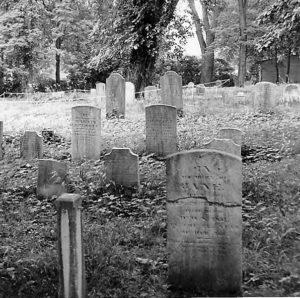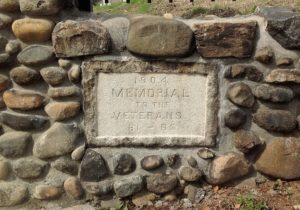The Little White Church Cemetery is located on Ashford Avenue just east of Storm Street.
Martin Lefurgy, who had owned this ancient community burying ground since 1785, donated it to the Presbyterian congregation in 1823. It was given to Dobbs Ferry in 1962. The last burial occurred in 1886.
There was a great deal of breakage of gravestones during the decades prior to the restoration efforts begun by the village in 2013. Between 2013-2014, restoration work was done in three phases.
In 2016 the village hired a conservator to do restoration work on twenty gravestones and to address other aspects of the appearance of the cemetery. We can see many formerly toppled and broken gravestone restored to upright positions from pieces that were lying and buried. Now we can read many additional names, dates, and sometimes epitaphs. Some gravestones are beautifully carved and others simple. Some for long-lived and some for children. It is a special piece of our heritage. The cemetery is open to all. Please visit.
The state of the cemetery before current renovations:
Deciding Who is Buried in the White Church Cemetery
On the face of it, it would appear an easy job to decide who is buried in a cemetery. Ideally, there are accurate records telling who was interred, when the burial occurred, where the grave is located and whether there is a marker. If such records exist for a cemetery, they can be incomplete or lost completely. Failing that, one can simply walk the grounds, noting the location of each stone and who it says is buried there. But even this can be misleading. A grave may contain more than one person which may not be reflected on the marker, if there even is one. Additionally, bodies that were buried might have been moved at some time, with the marker left in place. One other wrinkle are markers erected in memory of a deceased person whose body may lie elsewhere whose location is unknown. Many of these confounders exist in sorting out just who is buried in the White Church cemetery.
As part of the 2014 restoration of the cemetery, the listing for the White Church cemetery on Find A Grave was brought up to date. Find A Grave is a web-based resource which allows for memorial pages to be completed for people interred in any cemetery in the world. The White Church cemetery, known on Find A Grave as the Presbyterian Cemetery, listing can be found at https://www.findagrave.com/cemetery/863857/presbyterian-cemetery. There are 480 burials indicated with 28% of them having photos of the gravestones. This discrepancy is due in large part to the destruction of stones over the decades.
An article in the Dobbs Ferry Register (May 8, 1896) asked for information regarding the date of death and details of service of four Civil War veterans who were buried in the Presbyterian churchyard. (The cemetery grounds had been next to the original Presbyterian church building. In 1918, the Dobbs Ferry Register of May 31st reported on services being held in the cemetery for veterans buried there. The names of 10 men were listed.
An article in the Herald Statesman (Yonkers, NY) of November 22, 1955 entitled “Gravestones Provide Data on Dobbs Ferry Settlers” was a source of several dozen names of those interred.
In 1956, Rebecca Rankin, historian of the village of Dobbs Ferry compiled a list of those buried in the cemetery. The introduction to that list notes that “No original records of the cemetery could be found…” prompting Ms. Rankin and a committee to prepare a list, “…based on data from grave markers, church and undertakers’ records.”
The most recent major source of information about who is buried in the cemetery comes from an article by Caroline Kravath which appeared in The Ferryman (February 1990), describing the poor state of repair of the cemetery. This prompted the hiring of a preservation expert and subsequent survey and photographing of the stones and fragments. At the time of the survey, 214 stones were still standing.

